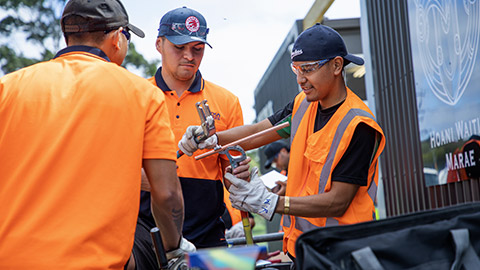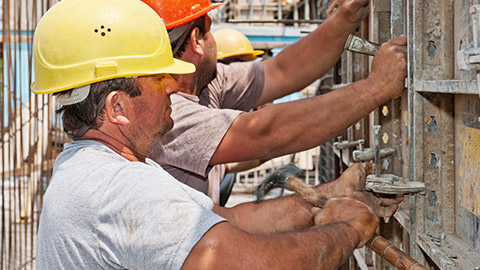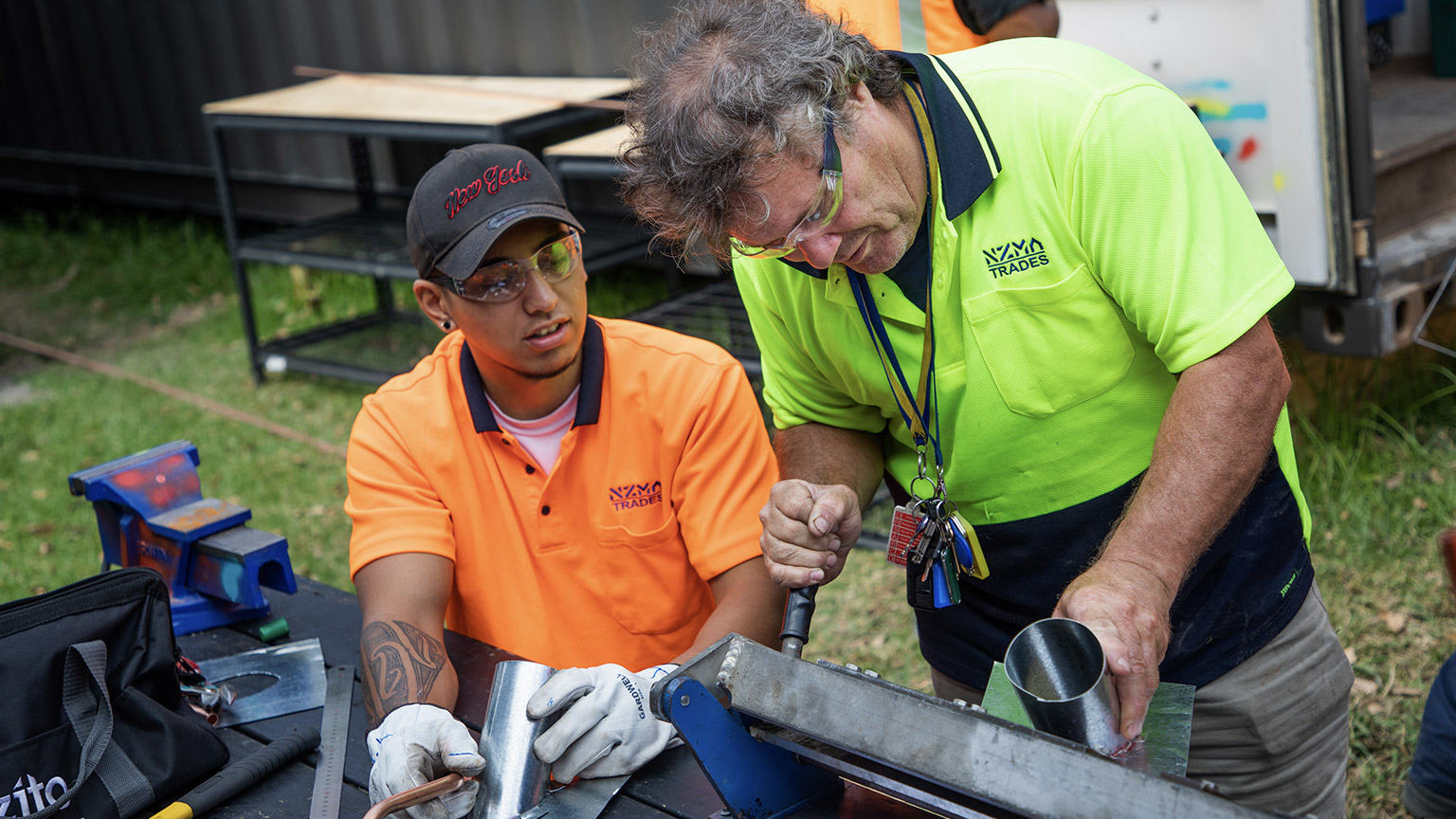Welcome to Prepare to Lead Team.
This is the first topic of our Leading and Monitoring Team module.
The learning outcome of this module is to allocate resources, supervise and evaluate team performance for an on-site residential construction work programme.
Module 7 Introduction from Will
Click ‘Video Transcript’ or the plus icon (+) to expand and reveal the transcript for the previous video.
Welcome to this module on Leading and Monitoring Teams. The learning outcome of this module is to allocate resources, supervise, and evaluate team performance for an on-site residential construction work programme. In this topic of Leading and Monitoring Team, we will aim to cover the following. Identifying barriers that may impact the team or team member’s performance. Identifying and addressing performance issues for individual team members. Monitoring and determining team performance and progress. Giving feedback and providing guidance to team members. Eliciting feedback from the team and reflecting upon own performance. Let’s dive into it.
Building a great workplace vibe is about keeping the communication flowing, fostering trust, and working together seamlessly.
As a leader in construction, knowing the ins and outs of your core team relationships is key. Sure, we often think of supervisors connecting with their teams, but it goes way beyond that. Your network includes the people you lead, others within your organisation, and those with whom you interact on-site.
In New Zealand, work culture values a flat structure. Even though there's an organisational chart, teams and managers have more of a side-by-side relationship than a strict top-down hierarchy. Your input and feedback as a supervisor or manager are valuable and help shape business decisions.
Let's look at how you, as the manager, interact with the three different groups of people.
- Self as manager and the subordinates
- Self as manager and the superiors
- Self as manager and other relevant stakeholders
Self as manager and the subordinates
The supervisor's first primary connection is with the team they oversee.
This could be your work buddies or your team members. The supervisor's main job is to amp up the team's game and get the buy-in to work towards the company goals.
Keeping the momentum up in this relationship means working within the team's best interests. Showing your crew that you walk the talk is a game-changer. Earn their respect, and you've got a crew that's got your back.
Self as manager and the superiors
The supervisor's next primary connection is with the higher-up team.
The higher-up team you work with will likely be the project manager or the company directors. These company decision-makers have the biggest say in cost management and budget control.
Here are some pointers to stay in line with their expectations:
- Develop detailed project planning within a realistic budget
- Monitor and control costs
- Recruit and maintain a skilled workforce
- Manage risk and have a contingency plan
- Monitor quality control
- Maintain client communication
Self as manager and other relevant stakeholders
The supervisor-stakeholder relationship, including the client, is another important one you'd want to maintain successfully.
Stakeholders encompass a diverse range of individuals and groups. This includes the clients, suppliers, regulatory bodies, etc. Maintaining a professional outlook when working with these external stakeholders is important, even when you have disagreements or grievances within your own team or company.
Be solution-focused and provide confidence to your stakeholders, especially the clients, when projects are on track and involve them strategically when you need to get their opinions or consent to problem-solve issues arising.

Team objectives refer to the goals a team wants to achieve.
Goals are set to oversee the construction team's onsite performance. The establishment of team goals is essential because:
- They keep team members motivated. Setting team objectives is a great way to keep your team motivated. It reminds them of the tasks that need to be done and the goals they want to achieve. It also reminds them that their actions contribute to a bigger project purpose.
- They ensure that each member is on the same page. Setting team objectives is important for fostering workplace transparency. These objectives ensure that all team members are well-informed about the project goals while guaranteeing an equitable allocation of tasks among the crew.
- They encourage collaboration between individuals. Team objectives help members work together towards a common goal. They help foster teamwork instead of a competitive and individualistic mindset. They also help members realise they can finish jobs faster if they work together.
The triple objective of project success
When defining the goals for your construction team, it's crucial to understand the objectives you should formulate clearly. You'll typically encounter a set of common construction team objectives in your workplace.
StrategiaConseil, a large construction company based in Canada, quoted that compliance with the triple objective of cost, time and quality (scope) is generally considered the criterion for project success.
Imagine you're in a tricky spot – you're building your dream home, and you've got this triangle dilemma to deal with.
It's like a Lego set where you can only pick two out of the three block options – Quality, Cost, and Time:
- Cheap and Good. Do you want it budget-friendly and top-notch quality? Well, brace yourself for a bit of a wait. Good things take time, right?
- Cheap and Fast. Need it done yesterday without breaking the bank? Fast and cheap, but here's the catch – you might have to compromise on quality. Quick doesn't always mean top-notch.
- Good and Fast. Dreaming of a quality home in record time? Well, that might hit your wallet a bit harder. High-quality work done in a jiffy often comes with a premium price tag.
It's like juggling these factors – you, the project manager and the client need to decide on which two they want to focus on for their project!
Average Perceived Success

As a supervisor, do you recognise your supervision style, and how does it interact with other styles on site?
People usually don't stick to just one leadership style. But it's good to know which style you lean towards more often. Understanding these leadership styles and how they play out can help you become a more flexible and effective supervisor.
Here are the top five leadership styles for you to uncover. Click the turn and next buttons to reveal the description for each style.
Reading
The previous 'turn the card' activity provides a brief overview of the leadership style and the impact it may have on staff. The following LinkedIn article expands on the 7-most-common-leadership-styles; take some time to read and explore other articles that might interest you.
Being a standout supervisor holds significant influence. Your conduct, actions, and how you treat employees not only directly affect them but also have an indirect impact on others.
Those under your supervision and management often progress to lead others, mirroring the style of supervision they experienced.
Achieving results and fostering morale
The key to successful supervision is obtaining results from your team while maintaining high morale. This involves focusing on employee engagement and fostering teamwork to ensure productivity and job satisfaction.
Delegating teams
Supervisors and managers in construction often rise through the ranks due to their ability to get things done. Yet, effective management in construction goes beyond personal achievements; it involves organising and guiding work through collaborative efforts. This requires skills, including setting expectations, giving feedback, coaching, motivating, and delegating tasks, which are essential for achieving project success collectively.
Team communication
Communication is a critical aspect of successful construction supervision. Navigating the challenges of effective communication is essential for fostering strong relationships within your construction team. Understanding and adapting to different personality preferences can enhance your ability to convey messages clearly and ensure that you grasp the perspectives of your team members.
Personal mastery
Successful construction supervision starts with effective self-management. Learn to explore the key strategies to present your best self and build room for skills development. Set standards for your daily routine and make those personal habits a space for you to ground yourself.

As front-line managers, supervisors must motivate workers to achieve the overall objectives of their organisation and communicate top management’s vision and policies to employees. The following are common qualities of effective supervisors:
Know their jobs
Effective supervisors possess a thorough knowledge of their job. Supervisors will otherwise be unable to command the respect of those working under them.
Make things happen
When others are intimidated or overwhelmed, effective supervisors are highly resourceful, finding innovative ways to draw upon internal and external resources to resolve problems and achieve goals.
Committed and responsible
Most employees admire supervisors committed to the organisation’s vision, goals, and tasks and take personal responsibility for carrying them out. Effective supervisors set a strong example for their staff members (e.g., arrive on time, actions and statements are consistent with the organisation’s mission).
Good communicator
Effective supervisors possess or acquire good communication skills that they regularly use in the workplace. Some duties that require excellent communication skills are as follows: giving clear instructions, explaining the rationale for a task, overseeing task execution, and presenting complex ideas in simple terms.
Respectful and courteous
The polite and courteous treatment of workers is another trait of effective supervisors. By treating everyone as worthy of respect and humane treatment, supervisors can achieve extraordinary results from their employees.
A spokesperson for the workers
Most of the time, the supervisor is the only person who can communicate the problems and ideas of the staff to middle and top management. Supervisors should also inform top management about high-performing employees and ensure they get credit for their ideas.
Develop people
Supervisors should train employees to perform their duties professionally and help them develop their full potential. This includes arranging for staff development and training and looking for ways to provide staff with new challenges and opportunities to expand their skills.
Insist on accountability
No one is perfect, and becoming more successful on the job is a learning process. Effective supervisors hold their staff members accountable and review their progress so that they can set and meet goals for improvement.

This subtopic will look at the crucial process of identifying and allocating resources in construction projects.
This includes materials, equipment, financial and human resources. We will explore strategies to optimise resource utilisation and ensure the right resources are allocated to the right tasks.
Material resources
Let's look at how to figure out what materials you need for a construction project. Here are some questions to help you with the identification process:
- What's your construction project all about?
- What needs to be done?
- What materials are required for each phase?
Continue with allocating material resources by using the following pointers.
- Project scope analysis: Start by understanding the scope of your construction project. A clear picture of the project's requirements will guide your material identification process.
- Specification check: Look into the project specifications and plans. What materials are mentioned or implied? This is your roadmap for identifying the specific types and quantities of materials needed.
- Supplier collaboration: Engage with suppliers early on. They're the experts in materials and can provide valuable insights. Discuss your project requirements, quality standards, and timelines to align expectations.
- Local regulations: Be aware of local building codes and regulations. Certain areas might have restrictions or requirements for specific materials. Ensuring compliance from the start avoids issues later in the project.
- Budget considerations: Assess your budget and identify cost-effective materials that meet quality standards. Balancing cost and quality is critical to successful resource identification.
- Alternative materials: Explore alternative materials that offer similar functionality but at a lower cost or with unique advantages. This can be a game-changer for staying within budget.
- Risk assessment: Identify potential risks associated with material selection. Consider factors like availability, lead times, and market fluctuations. Having a risk mitigation plan in place is smart.
Equipment resources
Let's dig into identifying and allocating equipment resources for your construction project:
- Understand project needs: Get a solid grip on your project requirements. What equipment does the job demand? Are you dealing with heavy machinery, specialised tools, or a mix of both? Knowing this sets the stage.
- Check equipment availability: Not all equipment might be readily available. Some machinery could be in high demand. Check with suppliers early to secure what you need. A well-timed reservation avoids last-minute scrambles.
- Assess equipment condition: Don't just focus on availability; quality matters, too. Assess the condition of the equipment. Is it up to the task? Well-maintained tools are your best buddies on the construction site.
- Cost considerations: Budget talk time. Different equipment comes with different price tags. Balance your project needs with your budget. Sometimes, a slightly pricier option might be more cost-effective in the long run.
- Safety first – compliance check: Safety isn't just a buzzword; it's a priority. Ensure the equipment meets safety standards and complies with regulations. An unsafe tool can lead to delays and, more importantly, accidents.
- Plan for downtime: Let's face it – even the best equipment needs a break. Plan for maintenance and downtime. It's a bit like giving your tools a fishing day to keep them in top-notch condition.
- Flexibility for changes: Construction projects are known for surprises. Keep your equipment plan flexible. If there are changes in the project scope or unexpected delays, having a flexible approach helps you adapt.
Financial resources
As a supervisor, you might not have complete control over your company's financial resources. However, together with your project manager, you could contribute towards managing the finances strategically.
Let's look at the influencing factors:
- Create a detailed budget: Start by making a detailed budget covering all project aspects, like materials, labour, and unexpected costs.
- Prioritise spending: Remember to put the first things first, such as initial groundwork and quality materials. Allocate funds where they matter most.
- Set aside for surprises: Keep a contingency fund for unexpected costs to handle surprises without harming the project's overall finances.
- Explore financing options: Find financing options—loans, grants, or partnerships—to align with your project's needs.
- Monitor finances regularly: Keep a close eye on spending compared to the budget. Regular monitoring allows timely adjustments for optimal resource use.
- Negotiate with vendors: Build good relationships with vendors for favourable terms. Negotiate discounts or bulk deals to allocate funds more efficiently.
- Be transparent: Maintain clear communication on financial matters with all stakeholders. Transparency builds trust and collaboration.
Human resources

The term Human Resources might be outdated, with companies using the term People and Culture instead. As a supervisor, you will identify the people you work with and allocate them to projects.
Here are some of the aspects for you to consider:
- Being the link between teams: A construction supervisor is like the glue that holds everything together. They ensure that the folks working within the company and those hired from outside (subcontractors) are all on the same page.
- Making sure things are top-notch: Quality is a big deal. The supervisor checks that the work, whether done by our in-house team or the subcontractors, meets the high standards we've set for the project.
- Juggling resources like a pro: Imagine managing a chess game with people and equipment. That's what a supervisor does – figures out who and what we need, where and when we need them, so everything runs smoothly.
- Solving issues like a pro: Construction sites can get tricky sometimes. Being a supervisor, there can be pressure to step in and solve every problem like a superhero. However, it is more important to empower your team. Equip them with the skills and confidence to resolve conflicts and keep things moving without a hitch.
- Safety first, always: Whether it's our team or the subcontractors, everyone's got to follow the safety rules. The supervisor ensures helmets are on, tools are used right, and everyone gets home safely.
- Keeping everyone in the loop: Talking is key. The supervisor keeps everyone – the bosses, the client, the teams, and the subcontractors – updated on how things are going, what challenges we're facing, and what victories we're celebrating.
- Watching the wallet: Money matters, right? The supervisor keeps an eye on the budget, making sure we're not spending too much. They determine how much we need for our team and the subcontractors to get the job done right.
- Staying on schedule: Imagine a big calendar for the project. The supervisor's job is to ensure everything happens when it's supposed to – no delays or dragging our feet.
- Being the crew's captain: Leadership is the lighthouse guiding the team in calm and stormy waters. The supervisor leads the charge, inspires everyone to do their best, and keeps the spirit high in our and the subcontractors' teams.

Resource management is deciding how to resource new work, assessing risk, and forecasting resourcing needs.
You might like a thin spread of marmite over your toast. However, spreading your resources too thin across multiple projects could backfire and jeopardise the team's overall success.
Have you worked on a project or projects where you think one or more of the previously mentioned resources are spread too thin?
Take the time to reflect on your past experiences and write them down in the next Documentation Tool.
